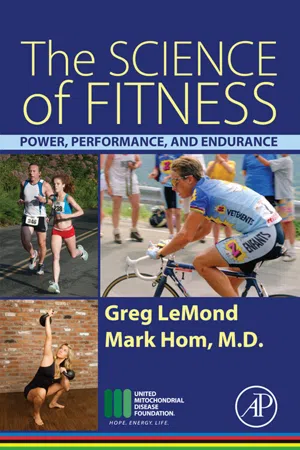
- 208 pages
- English
- ePUB (mobile friendly)
- Available on iOS & Android
About this book
The Science of Fitness: Power, Performance, and Endurance clearly explains the vital connection between diet and exercise in the human body. With this knowledge, you can use the right exercise and nutrition to obtain a higher quality life, prevent disease, and slow the aging process.Authored in a straightforward style and with color images throughout, this book explores the cellular science behind fitness, protein synthesis, and healthy living. With it you will learn the most recent and important discoveries in the relationships between physical fitness, nutrition, weight loss, and weight management. It provides key information on the body's mitochondrial processes and their role in aging, along with well-informed discussions on general nutrition, sports nutrition, exercise physiology, how to enhance athletic performance, and how exercise strengthens the mind.Whether you are interested in how to eat healthy, train for your first (or next) marathon, take your fitness to the next level, find the best super foods, or simply want to improve your vitality through healthy, doable practices, this book will help you on your journey regardless of age or fitness level.- Presents the connection between exercise, nutrition, and physiology in a way that is ideal for both experienced athletes and newcomers- Provides the scientific basis for mitochondrial functions and their relationship to fitness, protein synthesis, quality of life, and the aging process- Synthesizes the latest research on nutrition, sports nutrition, super foods, and the brain/body connection- Co-Authored by legendary cyclist Greg LeMond, who illustrates key points using his own athletic journey
Frequently asked questions
- Essential is ideal for learners and professionals who enjoy exploring a wide range of subjects. Access the Essential Library with 800,000+ trusted titles and best-sellers across business, personal growth, and the humanities. Includes unlimited reading time and Standard Read Aloud voice.
- Complete: Perfect for advanced learners and researchers needing full, unrestricted access. Unlock 1.4M+ books across hundreds of subjects, including academic and specialized titles. The Complete Plan also includes advanced features like Premium Read Aloud and Research Assistant.
Please note we cannot support devices running on iOS 13 and Android 7 or earlier. Learn more about using the app.
Information
Becoming a BEAST
Summary
Keywords
The BEAST system

Table of contents
- Cover
- Title page
- Table of Contents
- Copyright Page
- Author Biographies
- Foreword by Charles A. Mohan, Jr.
- Preface by Greg LeMond
- Preface by Dr. Mark Hom, M.D.
- Acknowledgments
- Disclaimer
- 1: Becoming a BEAST
- 2: The Human Machine
- 3: Amazing Mitochondria
- 4: Feeding Your Cells
- 5: Mitochondrial Supplements
- 6: Your Body at Work, Play, and Rest
- 7: The Body–Brain Connection
- 8: When Things Go Wrong
- 9: Slowing the Aging Process
- 10: Gauging Fitness
- 11: BEAST Fitness Training
- 12: The Finish Line…and a Starting Line
- Index